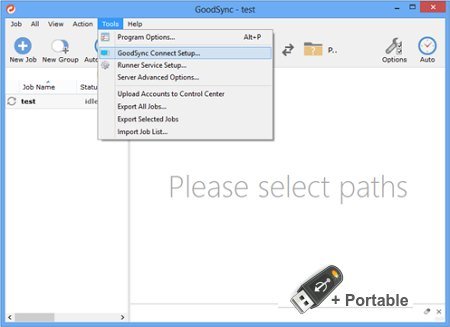
But changes, additions, or deletions on non-master computers do not propagate back to the master. That is, changes on the master always propagate to the other connected computers. Some products also give you the option to configure “master” folders, so that changes only flow in a single direction. Designated folders can be kept in sync across multiple computers, without requiring them to all be connected to a single local network. That is, after new files or changes are copied up to the internet, those same changes can be copied down to other computers connected to that account. Since synchronization can leverage the backup copies in cloud storage, it would be even better if the synchronization were automatic and built into my cloud solution. Therefore, my cloud storage needs to be compatible with synchronization.
#Goodsync login Offline
I’m too frequently disconnected from the internet, so I need offline access and local copies of my files. I’ve often found those clients have small feature sets, awkward interfaces, unreliable behavior, and a limited number of platforms. I would avoid products that limit your access via a proprietary client program. Some solutions also support standard protocols like WebDAV, SFTP, or Amazon S3 to allow apps to access files in cloud storage. JungleDisk even let you map a drive letter to the internet storage so it would appear like normal storage to all your programs. Cloud Driveīecause the files are copied to the internet, many vendors will let you access that copy from a browser or mobile device. It lists the other factors that can supplement your cloud storage so that you have a real backup. See my discussion of the 3-2-1 best practice below. If you accidentally corrupt a file, or if a malicious virus were to encrypt your files, that damage would propagate and thus destroy any “backup.” Also consider how you will be impacted if the vendor has technical difficulty and goes offline. Online backups can be a component of a backup strategy, but by itself it can lead to trouble. Here are some of the top benefits:įiles created on a computer or a device automatically get copied to storage on the internet. Depending on the product, you can leverage cloud storage in additional and useful ways. And cloud access let me remain functional and keep my momentum until I could purchase a laptop replacement. Cloud technologies allowed me to survive the loss of that computer and its files. These let you keep files on the internet, which is sometimes referred to as “cloud storage.” The awesome benefit of internet storage and access came into sharp focus for me after losing a laptop to a burglar in 2010. You may be familiar with cloud storage products like DropBox, Google Drive, Microsoft OneDrive, and Apple iCloud.


Then a recent decline in GoodSync reliability and support inspired me to write about these cloud technologies, the products I evaluated, and the strategies I followed to optimally leverage them. For years my solution was centered around JungleDisk, but a change of ownership led to a switch to GoodSync. I’m a fan of cloud storage, internet backups, and automatic file synchronization between computers.


 0 kommentar(er)
0 kommentar(er)
